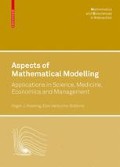Abstract
The paper deals with a long-standing problem in the debate on economic growth — viz. the issue of stability of the balanced growth path in macroeconomic growth models. We first consider an early claim that the replacement of a fixed coefficients technology by a neoclassical production function provides the solution to the Harrod-Domar knife-edge instability problem, and proceed to investigate the stability and onset of oscillations in an “augmented” neoclassical model of macroeconomic growth. The model embeds a Constant Elasticity of Substitution (CES) production function, sluggishly adjusting and non-market-clearing real wages, and endogenous fertility. The analysis shows that (i) Solow models may suffer instability; (ii) a spark-triggering instability may be due to the presence of a too strong “neoclassicity” in production; and (iii) strong “neoclassicity” may lead to sustained oscillations of the economy and also to knife-edge instability.
Access this chapter
Tax calculation will be finalised at checkout
Purchases are for personal use only
Preview
Unable to display preview. Download preview PDF.
References
Ahn, H., Mira, P., 2001. Job bust, baby bust? Evidence from Spain. Journal of Population Economics. 14,3, 505–521.
Barro R. J., Sala-y-Martin X., 1995. Economic Growth. New York: McGraw-Hill.
Fanti L., Manfredi P. 1998, A Goodwin-type Growth Cycle Model with Profit-sharing, Economic Notes 3, 183–214.
Fanti L., Manfredi P., 2003a. Population, Unemployment, and Economic Growth Cycles: a further explanatory perspective, Metroeconomica 54,2, 179–207.
Fanti L., Manfredi P., 2003b. The Solow’s Model with Endogenous Population: A Neoclassical Growth Cycle Model, Journal of Economic Development 28,2, 103–115.
Fanti L, Manfredi P., 2006. Neoclassical labour market dynamics, chaos and the real wage Phillips curve, Journal of Economic Behaviour and Organisation 62,3, 470–483.
Fazzari S, Hubbard R., Petersen B., 1988. Financing Constraint and Corporate Investment, Brookings Papers on Economic Activity 1, 141–195.
Goodwin R. M., 1972. A growth cycle. In Hunt E.K., Schwartz J.G. (eds.). A critique of Economic Theory. Harmondsworth.
Jones C.I., 1999, Was an Industrial Revolution Inevitable? Economic Growth Over the Very Long Run. Cambridge, MA: NBER, WP 7375.
Holt C. C, 1970. Job Search, Phillips Wage Relation and Union Influence. In Phelps E. S. (ed.), Microeconomic Foundations of Employment and Inflation Theory. New York: Norton & Co.
Lipsey R. G., 1960, The Relation Between Unemployment and the Rate of Change of Money Wage Rates in the U.K. 1861–1957: a Further Analysis. Economica 27, 1–31.
Manfredi P., Fanti L., 2000a. Long term effects of the efficiency wage hypothesis in a Goodwin-type model, Metroeconomica 51,4, 454–481.
Manfredi P., Fanti L., 2000b. Long term effects of the efficiency wage hypothesis in a Goodwin-type model: a reply. Metroeconomica 51,4, 488–491.
Manfredi P., Fanti L., 2006a. The complex effects of demographic heterogeneity on the interaction between the economy and population. Structural Change and Economic Dynamics 17, 148–173.
Manfredi P., Fanti L., 2006b. Demography in Macroeconomics Models: When Labour Supply Matters for Economic Cycles. Metroeconomica 57,4, 536–563.
Momota A., Futagami K., 2000. Demographic transition pattern in a small country, Economics Letters 67, 231–237.
Solow R. M., 1956. A model of balanced growth, Quarterly Journal of Economics 70, 65–94.
Solow R. M. 2000. Growth Theory. New York: Oxford University Press.
Solow R. M., Tobin J., von Weizsacker C.C., Yaari M. 1966. Neoclassical Growth with Fixed Factor Proportions. Review of Economic Studies, 33,2.
Southall, H., Gilbert, D. 1996. A good time to wed? Marriage and economic distress in England and Wales, 1883–1914. Economic History Review 49,1, 35–57.
Staiger, D., Stock, J.H., Watson, M. W., 2001. Prices, Wages and the US NAIRU in the 1990s. Cambridge, MA: NBER, Working Paper 8320.
Van der Ploeg F., 1985. Classical Growth Cycles, Metroeconomica, pp. 221–230.
Kaldor N., 1957. A model of economic growth, Economic Journal, 57, 591–624.
Guckenheimer J., Holmes, P., 1983. Nonlinear oscillations, dynamical systems, and bifurcation of vector fields. New York, Tokyo: Springer-Verlag
Author information
Authors and Affiliations
Editor information
Editors and Affiliations
Rights and permissions
Copyright information
© 2008 Birkhäuser Verlag Basel/Switzerland
About this chapter
Cite this chapter
Fanti, L., Manfredi, P. (2008). Instability and Sustained Oscillations in Neo-Classical Growth Models with Unemployment. In: Hosking, R.J., Venturino, E. (eds) Aspects of Mathematical Modelling. Mathematics and Biosciences in Interaction. Birkhäuser Basel. https://doi.org/10.1007/978-3-7643-8591-0_19
Download citation
DOI: https://doi.org/10.1007/978-3-7643-8591-0_19
Publisher Name: Birkhäuser Basel
Print ISBN: 978-3-7643-8590-3
Online ISBN: 978-3-7643-8591-0
eBook Packages: Mathematics and StatisticsMathematics and Statistics (R0)

